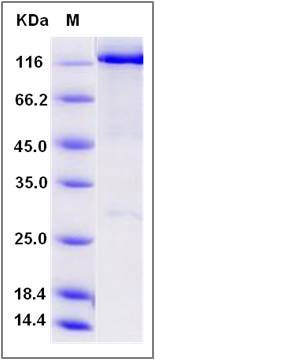Human WWP2 Protein (His & GST Tag)
AIP2,WWp2-like
- 100ug (NPP2583) Please inquiry
| Catalog Number | P13125-H20B |
|---|---|
| Organism Species | Human |
| Host | Baculovirus-Insect Cells |
| Synonyms | AIP2,WWp2-like |
| Molecular Weight | The recombinant human WWP2 /GST chimera consists of 1107 amino acids and has a calculated molecular mass of 126.7 kDa. The recombinant protein migrates as an approximately 120 kDa band in SDS-PAGE under reducing conditions. |
| predicted N | Met |
| SDS-PAGE |  |
| Purity | > 90 % as determined by SDS-PAGE |
| Protein Construction | A DNA sequence encoding the human WWP2 (O00308) (Met1-Glu870) was fused with the N-terminal polyhistidine-tagged GST tag at the N-terminus. |
| Bio-activity | |
| Research Area | Signaling |Signal Transduction |Nuclear signaling |Nuclear hormone receptors |Co-activators/co-repressors |
| Formulation | Lyophilized from sterile 20mM Tris, 500mM NaCl, pH 8.0, 10% glycerol 1. Normally 5 % - 8 % trehalose, mannitol and 0.01% Tween80 are added as protectants before lyophilization. Specific concentrations are included in the hardcopy of COA. |
| Background | WWP2 contains 1 C2 domain, 1 HECT (E6AP-type E3 ubiquitin-protein ligase) domain and 4 WW domains. It is an E3 ubiquitin-protein ligase which accepts ubiquitin from an E2 ubiquitin-conjugating enzyme in the form of a thioester and then directly transfers the ubiquitin to targeted substrates. WWP2 can be detected in heart, throughout the brain, placenta, lung, liver, muscle, kidney and pancreas. It is also expressed in spleen and peripheral blood leukocytes. WWP2 polyubiquitinates POU5F1 by 'Lys-63'-linked conjugation and promotes it to proteasomal degradation; in embryonic stem cells (ESCs) the ubiquitination is proposed to regulate POU5F1 protein level. WWP2 ubiquitinates EGR2 and promotes it to proteasomal degradation; in T-cells the ubiquitination inhibits activation-induced cell death. It also ubiquitinates SLC11A2; the ubiquitination is enhanced by presence of NDFIP1 and NDFIP2. WWP2 ubiquitinates RPB1 and promotes it to proteasomal degradation. |
| Reference |
